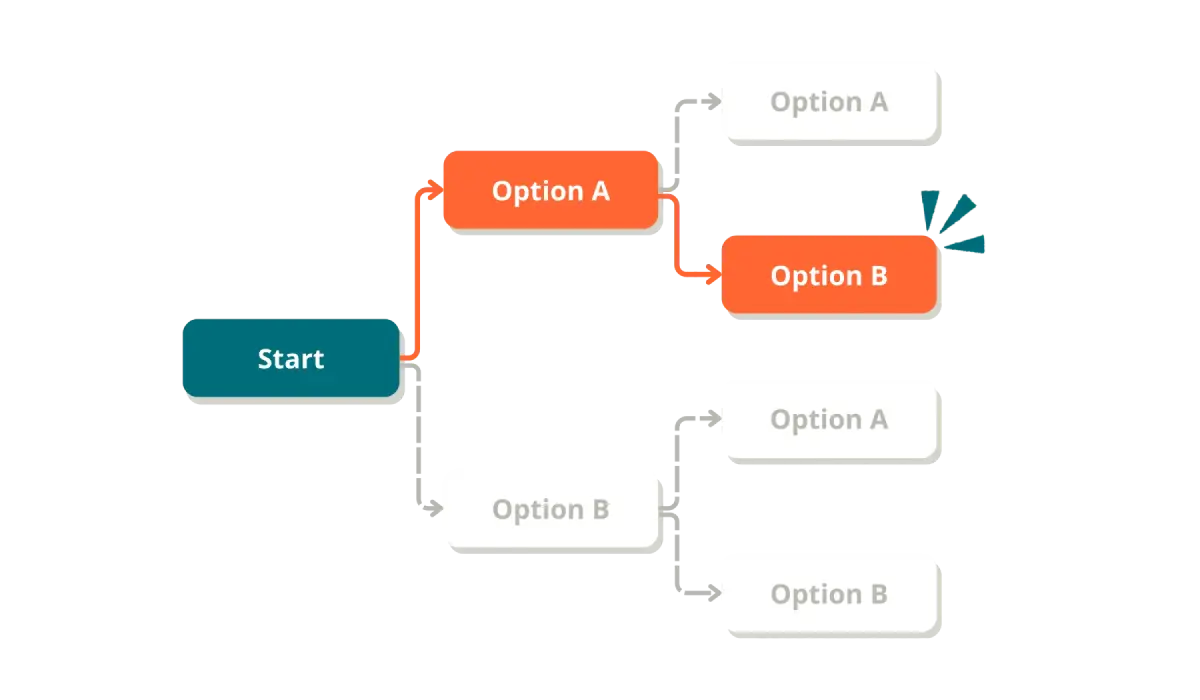What are branching scenarios?
Share on socials
What are branching scenarios, and why use them?

Jump to Section
Jump to section
What are branching scenarios?
Benefits of branching scenarios
Where to use branching scenarios
Creating engaging learning experiences
Case studies and success stories
What outcomes can you expect?
Branching scenarios take the thrill of a 'choose your own adventure' and apply it to your course, business training, or new project.
Most training experiences are ‘one size fits all’ or uninspiring, which is why branching scenarios stand out. Branching scenarios offer personalised, active learning content, letting users consider scenarios they'll likely encounter in a safe, virtual world to gain confidence before they experience them in real life. It's a win-win.
Already in the know and want to get started with branching scenarios? Put them to good use in a customer onboarding guide, employee handbook, and more!
Already in the know and want to get started with branching scenarios? Put them to good use in a customer onboarding guide, employee handbook, and more!
What are branching scenarios?
Simply put, branching scenarios are interactive learning experiences that give users a series of decision points, where their choices dictate the outcome of the scenario. They’re commonly used in e-learning, training simulations, and interactive fiction.
With branching scenarios, users can roleplay the effects of making decisions in a safe training space. Branching scenarios create simulation-based learning unique to almost any environment where decision-making or situation-management skills will be required.
With branching scenarios, users can roleplay the effects of making decisions in a safe training space. Branching scenarios create simulation-based learning unique to almost any environment where decision-making or situation-management skills will be required.

In branching scenarios, a user's decisions directly influence the outcome
The benefits of using branching scenarios
Branching scenarios help build the critical thinking skills needed for real-world decision-making. By tailoring the learning journey to each individual, they allow learners to gain practical, relevant knowledge without needing direct on-the-job experience - a huge advantage in high-risk environments.
But the benefits don’t stop at the ‘quiz’ stage. Entire knowledge bases can be organised around branching scenarios to provide crucial information at the right time - think onboarding and ongoing training. It’s a smart way to make learning engaging, relevant, and impactful when it matters most.
But the benefits don’t stop at the ‘quiz’ stage. Entire knowledge bases can be organised around branching scenarios to provide crucial information at the right time - think onboarding and ongoing training. It’s a smart way to make learning engaging, relevant, and impactful when it matters most.
Where to start using branching scenarios
There are many use cases for branching scenarios - here are just a few ways you can make them work for you.
Education:
From classrooms to lecture halls, branching scenarios are transforming traditional teaching methods, making learning more immersive and personalised. The 'why' of learning matters, and with branching scenarios, it's possible to show students the importance of solving a problem in one particular way, helping to get all students on a level playing field.
Corporate training:
Branching scenarios are often used in corporate settings, where they are increasingly employed for skills development, onboarding, and decision-making training. Branching can be used to model a sales scenario or how to engage with an angry customer.
Healthcare and simulation:
Even in a high-stakes environment, branching scenarios can upskill employees. That's why everyone, from astronauts to surgeons, are getting involved with branching simulation scenarios! The latest models can even use evidence-based guidelines, telehealth, medication information resources, and electronic medical records to help guide decisions.
Creating engaging learning experiences with branching scenarios
Branching scenarios encourage learner engagement - but only if the pathway is highly personalised. A simple question, such as, 'If a customer wishes to cancel a contract, what do you do?', could have two incorrect next steps, and one correct one. If the learner picks an incorrect move, they should get feedback on the consequences, and then be offered a brand new question related to this issue. When they get answers right, they should also be able to access relevant supporting material. This is known as ‘divergent branching design', where each stem divides into new pathways and doesn't return - a bit like real life!
This approach is a time investment, but lets you create branching scenarios as part of a learner experience with clear links between steps, meaning crystal clear understanding and no missed information.
If you create or manage documentation, using branching scenarios will allow you to organise your content so users never get lost and can drive those great behaviours through to real-life situations.
Don't forget: you need content that is visually engaging and meaningful. Are your branching scenarios interactive? Are they adaptive or do they feel static? The right scenario-based e-learning design should closely mimic reality. Don't scrimp on this stage!
This approach is a time investment, but lets you create branching scenarios as part of a learner experience with clear links between steps, meaning crystal clear understanding and no missed information.
If you create or manage documentation, using branching scenarios will allow you to organise your content so users never get lost and can drive those great behaviours through to real-life situations.
Don't forget: you need content that is visually engaging and meaningful. Are your branching scenarios interactive? Are they adaptive or do they feel static? The right scenario-based e-learning design should closely mimic reality. Don't scrimp on this stage!
Case studies and success stories
There are many successful implementations of branching scenarios. A chronic illness branching simulation has been shown to provide “an excellent opportunity to train students… that supports rapid, real-time decision-making in emergency situations that will positively influence patient outcomes”.
NASA uses branching simulation and states that it offers several benefits "particularly the introduction of feedback and reinforcement... individualised instruction, potentially saving time, money, and effort among the higher ability trainees".
Virtual reality integration, artificial intelligence enhancements, and adaptive learning technologies will all play a significant part in the development of what branching scenarios look like in the near future, but you don't have to be a national space agency to get involved. Branching can get any student or team member ready for what's ahead.
NASA uses branching simulation and states that it offers several benefits "particularly the introduction of feedback and reinforcement... individualised instruction, potentially saving time, money, and effort among the higher ability trainees".
Virtual reality integration, artificial intelligence enhancements, and adaptive learning technologies will all play a significant part in the development of what branching scenarios look like in the near future, but you don't have to be a national space agency to get involved. Branching can get any student or team member ready for what's ahead.
What outcomes can you expect?
Whether you're off to space or have more modest goals, you should definitely expect increased learner retention, as well as boosted overall engagement with your programme compared to more static approaches to learning.
After a few rounds of branching scenarios, users should show improved decision-making skills and should have a good basic understanding of the material that has been provided. The results should be evident, and exciting!
After a few rounds of branching scenarios, users should show improved decision-making skills and should have a good basic understanding of the material that has been provided. The results should be evident, and exciting!

Want to create branching forms in Confluence?
With conditional fields included in Forms for Confluence, you can create dynamic forms and surveys in minutes. Experience it completely free for 30 days.
Related Content
Read moreWritten by

Content Writer
Elaine has established herself as a respected authority in the HR industry and uses her experience gained as the head of marketing in the employee rewards and recognition software sector to inform her reporting.
Related Content
Read more


